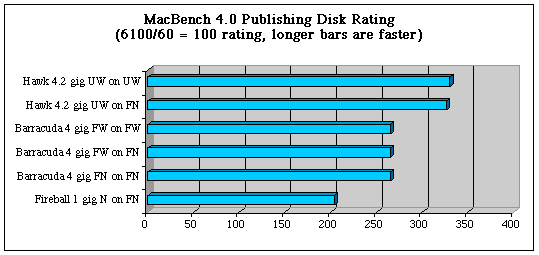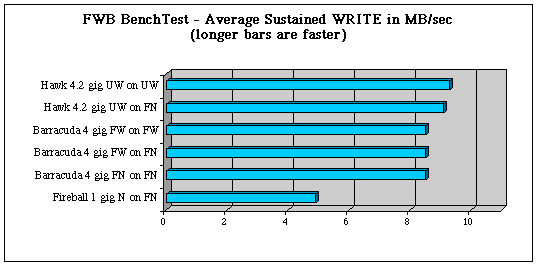
A speed comparison between 4 Gig hard drives
under $300
(Updated 3/10/98 To separate average sustained READ from WRITE in
the FWB BenchTest results. Updated 3/5/98 to add the results from
the Fast Wide version of the Barracuda running in both Wide and
Narrow mode as well as the results from the Hawk Ultra Wide drive
running in Fast Narrow mode. All graphs updated and all new text
is in RED, including a note about Apple versus FWB drivers.)
© 1998, 1999 Rob Art Morgan, editor of BARE FEATS
Gotta Question? Comment? Want to advertise?
Email Rob Art at barefoot@hawaii.rr.com
A lot of you out there have indicated to me that you have Power Macs with 1 or 2 Gig Quantum Fireball SCSI hard drives that are full and fragmented and no so fast.... just like me... right?
With the announcement of MacOS 8.1 and HFS+ many of you are prepared to spend three or four hundred for a 4 gig drive. You were thinking of pouncing on that special deal on the $265 Seagate 4.3 gig Barracuda (ST15150N or ST15150W) advertised by Digitek and Other World Computing. How can they sell that Barracuda for half the price of those other Barracuda 4 gig drives you saw? Inquiring minds want to know, but first, the speed test results:




The Scoop
FACT 1: Even the "Bargain Barracuda" is
significantly faster than the old Fireball,
as you can see from the charts above.
FACT 2: Not all Barracudas are created
equal.
The Barracuda (ST15150N) is a "Fast Narrow SCSI-2" drive with a
maximum theoretical speed of 10MB/Second. The Barracuda (ST15150W)
is a "Fast Wide SCSI-2" drive with a maximum theoretical speed of
20MB/Second. The more expensive 4.3 Barracuda offered for $399 by
Macworks is an Ultra Narrow
(20MB/sec) drive. The $589 4.3 Barracuda offered by MacGurus
is an Ultra Wide (40MB/sec) drive. There are NUBUS and PCI based
controller boards that will enable your Mac to take some advantage
of these more expensive drives' faster theoretical speed.
CAUTION: be aware that bargain drives advertised as "WIDE" may
only be SCSI-2 and not SCSI-3 (Ultra Wide).
I haven't been able to get my hands on an Ultra Wide Barracuda but I did test the Seagate Hawk Ultra Wide (ST34555W) drive which is the ultra wide drive closest in price ($384.99 from MacGurus) to the bargain Barracudas. I ran the Fast Wide and Ultra Wide drives both WITH and WITHOUT the aide of a borrowed Adaptec 2940UW Ultra Wide controller (courtesy of MacGurus).
FACT 3: Maximum Theoretical Transfer Rate
is almost meaningless
I received tons of technical feedback from readers regarding the
theoretical transfer rates and interface options. I approached
these tests purposefully as "Joe Consumer" who simply wants to
know, "How fast will this puppy go when I floor it?"
When you examine the charts above, two things should strike
you:
1. The speed has more to do with the DRIVE than the INTERFACE.
2. None of the drives approached the theoretical maximum speed
regardless of what interface was used.
To go much faster, "Joe Consumer" will have to spend a lot more
than $300 or $500.
I stopped publishing the chart showing Peak Random Write Speed because I concluded it was meaningless in the real world.
FACT 4: Choice of Driver Does Make A
Difference
At least in the case of the Hawk drive running in Narrow mode, I
observed a significant difference in the times generated using
Apple's Drive Setup 1.4 and FWB's Hard Disk Toolkit 2.0.6. The
Average Sustained Write Speed jumped from 4MB/sec to 8MB/sec when
I switched from from Apple to FWB. I didn't believe it so I
reformatted the drive with each driver a second time and reran the
tests. Same result. In the case of MacBench's Publishing Disk
Test, with Apple's driver, I got a 207 rating. With FWB's, I got a
326 rating.
FACT 5: You May Need A/C & Ear
Muffs
Several of you have emailed me asking me to mention that the
Bargain Barracudas (ST15150U & W) run very hot and are very
noisy. The two I tested were too hot to touch when running. They
made a strange combination of noises at startup and were noisier
than any other drive I've ever used during operation. In fact, I
found even the spin noise to be irritating. Note also that the
drives are an inch and a half high so they were a squeeze fit in
the bottom bay of my 7500. (When I put them in the top bay, I
couldn't close the lid.)
The newer Barracudas (such as the ST32272 4XL series) feature low power consumption, low heat output, very high reliability figures (1,000,000 MTBF) low-profile size, very high areal density and better speed than earlier models.
Power Macintosh 7500 with PowerLogix PowerBoost Pro 233 running
at 250/50.
80MB of RAM, 1MB Level 2 Cache (RapidCache), disk cache set to
512K
Mac OS 8.1
The Quantum Fireball 1080 and Seagate Barracuda 15150N were
connected to the built-in Fast Narrow interface.
Seagate Barracuda 15150W & Hawk ST34555W were tested connected
to the to an Adaptec 2940UW PCI "wide" controller board as well as
connected to the built-in Fast Narrow interface.
All drives were freshly formatted using FWB's Hard Disk Toolkit
2.0.6 in Standard HFS.
© 1998, 1999 Rob Art Morgan, editor of BARE FEATS
Gotta Question? Comment? Want to advertise?
Email Rob Art at barefoot@hawaii.rr.com